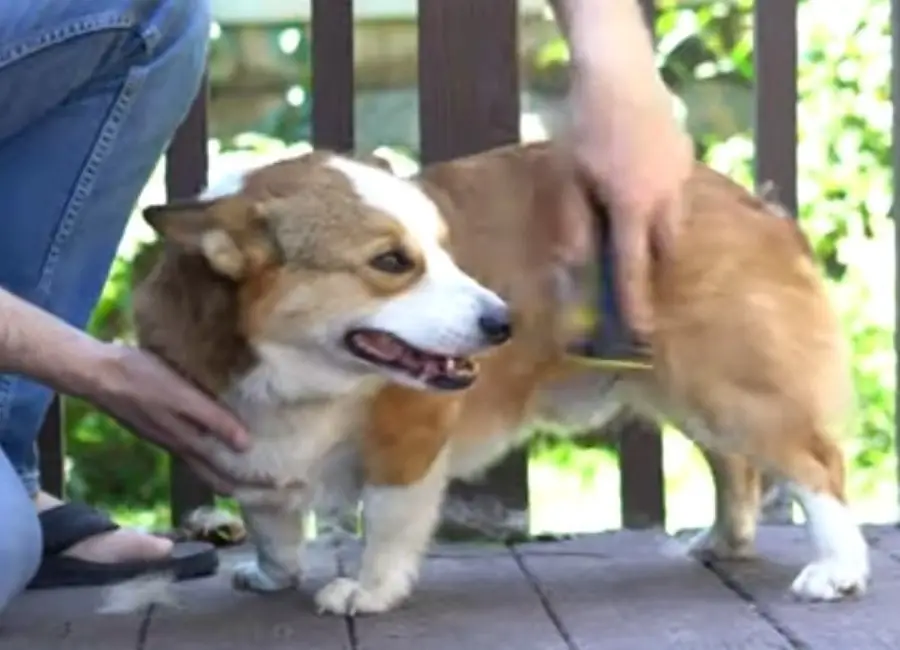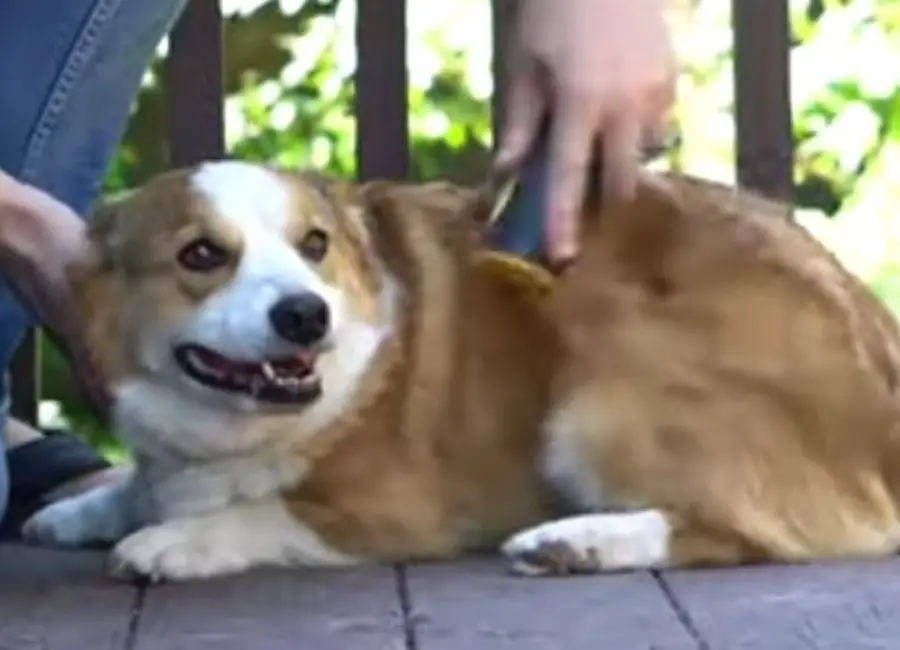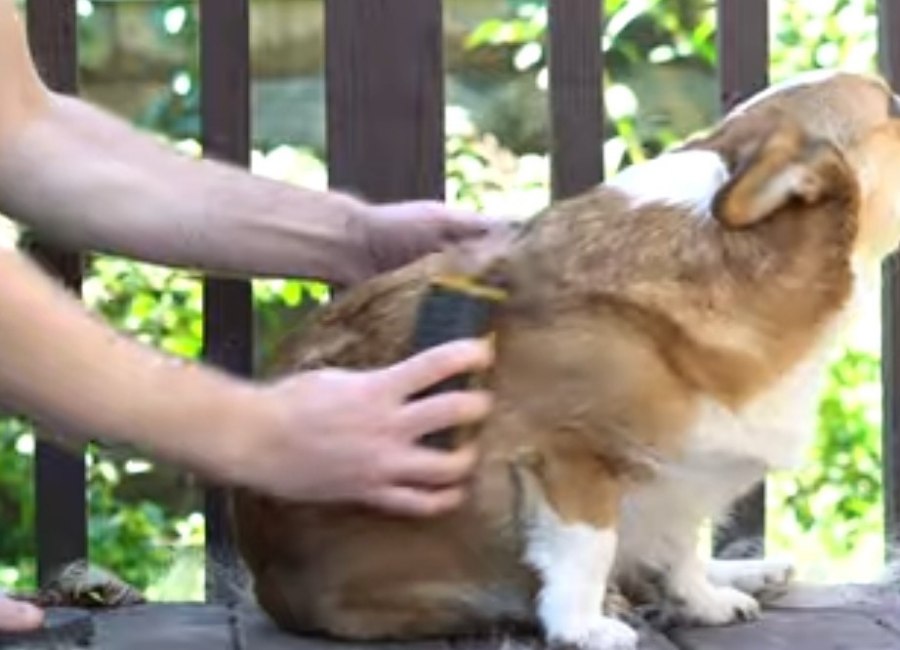9 Hints To Corgi Shedding Control & More

Corgi shedding is one of the issues most corgi owners face, and that is what this post is all about, especially things that cause excessive shedding.
Corgi shedding is something you can’t stop or prevent because corgis have undercoats that they do shed from time to time.
However, there are many ways to minimize or control excessive corgi shedding which we will outline in this post so keep reading.
Do corgis shed a lot?

Yes, Corgis do shed quite a bit all year round because they have a double coat, but spring and autumn are when they shed the most, hence corgis can be classified as a shedding breed.
Although all corgis shed to some extent, it is a natural process that protects their skin and helps them regulate their body temperature.
Due to their double coat, corgis shed more than most other breeds of dogs.
Vitamins, grooming, and diet can all help minimize excessive corgis shedding, but it cannot be stopped.
Controlling corgi shedding

The most popular and efficient methods for controlling excessive shedding in corgis are listed below:
1. Regular brushing of your corgi
Regular brushing of your corgi could be daily brushing or brushing your corgi around 2 to 3 times per week.
Regularly brushing of your corgi help remove dead stuck hairs since they have undercoats.
This regular brushing also help distribute the natural oil on your corgi skin as well as remove dirt on their skin.
One of the best ways to remove stray fur from your corgi’s coat and prevent him from overshearing is to brush him frequently.
Try utilizing deshedding products (like furminators) and other double-coated puppy-specific grooming tools, including grooming gloves or mittens, before using a bristle brush.
How often should I brush my Corgi
It is a good habit to brush your corgi at least twice a week for 10 to 12 minutes at a time.
Make sure to always brush in the direction of the hair, never the opposite.
How to make grooming corgi easy
Here are some pointers to help you and your corgi maintain proper grooming:
- Once your corgi arrives at your house, begin grooming exercises.
- Find out the ideal grooming equipment from your veterinarian.
- Maintain a regular grooming schedule and don’t forget to do it.
- Before and after grooming, always give out snacks.
- By sniffing the grooming implements, you may help your corgi grow accustomed to them.
- In order for your corgi to enjoy grooming, link it to excellent training.
2. Provide high quality dog food
Watch how much food your corgi is eating. All dogs have less shedding and healthier skin when they eat a balanced diet.
The food of a corgi should be healthy and well-balanced to minimize the excessive shedding.
How properly you feed your corgi will affect the state of his coat health.
Even a little interior hair loss may be reduced by giving your corgi a balanced diet.
3. Provide extra supplement
If your corgi consumes dog food rich in Omega-3 fatty acids, oils, and minerals, her hair and skin will be as silky and healthy as possible.
Dietary supplements frequently contain natural fatty acids like omega-3 and omega-3 fatty acids, which are especially beneficial to corgis and help maintain the health of their skin and hair.
Talk with your veterinarian for the right type of supplements you can get for your corgi. Good supplements can help in fixing corgi shedding.
4. Avoid any form of dehydration
Make sure your corgi has access to clean drinking water at all times to prevent dry skin and to increase your dog’s body temperature.
This is crucial because dogs that drink insufficient amounts of water tend to have dry skin and hair, which increases their tendency to shed excessively.
If you keep your dog’s water bowl clean and full, there is less likelihood that harmful bacteria may be ingested.
Make sure your corgi is only drinking pure water by checking their water dishes.
Most dogs like corgis who are dehydrated might experience shedding and other health issues.
Make sure your corgi always has access to fresh water as a result to avoid dehydration which can lead to unnecessary corgi shedding.
5. Stop switching out the corgi food
Avoid starting your corgi’s excessive shedding on your own; corgis tend to shed unnecessarily when they switch foods.
Be cautious to stay with what is working for you because corgis are quite sensitive and might shed in response to a new meal.
If there is a need to switch foods, you, your vet, and your corgi should all agree on it by getting a better replacement not what you see online.
Even with your veterinarian’s clearance, pay special attention to how your corgi responds while changing foods.
Loss of appetite, an increase in body warmth, excessive water consumption, unneeded coughing, and food rejection are things to watch out for while altering your diet.
6. Keep your corgi away from stale food and table scraps
Corgis may have gastrointestinal upset after consuming table scraps or old food, which leads to excessive shedding.
Are you conscious that allowing your corgi to consume table scraps on the floor may cause a bacterial illness and result in unneeded corgi shedding!
It is not a good idea to let your corgi eat off the ground; instead, give your dog food in a clean container.
Don’t let your corgi steal food off the table while you’re eating; it’s not a good idea.
Keep corgis away from table leftovers and old food since their stomachs are delicate and may rupture if they consume them.
7. Give your corgi a bath regularly
Bathing your corgi not only keeps its skin clean but also helps to reduce its body temperature, which is important for corgi shedding.
Ask your veterinarian what shampoo is best for your corgi, and follow all of the instructions carefully.
After a wash, be careful to dry your corgi; do not let your corgi dry itself as this will take some time.
Being exposed to needless attacks by having your corgi’s skin moist is really bad.
You should always dry your corgi after every wash since they can stink if they are kept wet for a long time.
8. Keep allergies away from your corgi
An allergic reaction manifests itself in a variety of ways, including itchy ears, frequent biting at your corgi’s skin, tears welling up in your corgi’s eyes, and frequent licking of the paw or skin.
One of the most important things you can do to prevent your corgi from excessively shearing is to get rid of allergies.
Pollen, mold spores, dust mites, and dead skin cells are just a few allergens that can cause allergic reactions in corgis.
Keep an eye out for rashes or hair loss in your dog’s skin or hair that might indicate a food allergy.
Keeping your corgi away from allergies can help in fixing corgi shedding excessively.
9. Control parasite or pest attack
Preventing corgi shedding in corgis is essential, whether it’s due to fleas, worms, or ticks.
Corgis may shed because to external irritants including fleas, ticks, and allergies.
It may be able to reduce unnecessary shedding by protecting your corgi from these irritants.
Under a veterinarian’s care, allergies may be diagnosed, treated, or managed, and flea and tick collars are simple and effective.
Causes of excessive shedding in corgis
The most frequent reasons for excessive shedding in corgis are poor diet, infrequent brushing, parasite infestations, allergies, and the time of year.
Some of the most prevalent causes of excessive shedding in corgis are the ones listed below:
1. Time of the year
Time of the year is one of the main causes of corgi shedding, as seasonality affects the rate or amount of shedding.
Corgi hair will shed much more in the spring than it does in the winter.
So it becomes sense to assume that corgi shedding is affected by the season.
In order to avoid the summer heat, corgis lose their winter coats in the spring, and in order to reinforce them in the winter, they gain hair in the summer.
In the spring, keep your corgi’s temperature down as warmer weather makes them sweat less.
You’ll be astonished at how much your corgi sheds if you don’t take care of them throughout the summer.
2. Sudden changes in hormones
A hormonal condition called hypothyroidism in dogs can cause substantial hair loss.
It affects the corgi’s thyroid glands, which results in a lack of the hormone thyroxine, which controls metabolism.
This illness results in weight gain, weariness, thinning hair, a thin coat, discolored areas on the skin, and skin discoloration.
Your female corgi’s heat cycles may affect how much fur she loses at once if she hasn’t been neutered.
At the conclusion of her cycles, you could notice her shedding more hair.
All of these causes of hair loss are referred to as hair loss triggered by hormone shifts.
3. Parasite attack
Outside-going corgis are more prone to parasites like fleas, mites, and lice, but they also lose a lot of hair as a result of the invasion.
One of these insects can bite you once and cause a number of issues, including excessive shedding.
Corgis dislike bug bites, and this one could cause some shedding despite the minimal quantity of shedding.
Your corgi will continue to shed until the parasite is gone if she has one.
As a result, the corgi will scratch itself until it becomes bald in certain places.
Because flea bites can cause severe allergic reactions, keep your corgi away from them.
4. Allergies
Due to sensitivities to specific foods or environmental contaminants, corgi’s skin may become irritated and can lead to corgi shedding.
Your corgi may scratch, lick, or bite themselves out of the allergy, resulting in significant hair loss.
Food, dust, medications, and insect bites are just a few of the things that might make corgis allergic.
When corgis come into contact with anything they are sensitive to, their skin reacts allergically, which causes their hair to fall out.
This is a rare kind of shedding that only sometimes takes place.
Keep your corgi away from any allergens as it can definitely help with corgi shedding issues.
5. Poor nutrition
Poor nutrition is a sure way to increase corgi shedding.
One of the most frequent causes of excessive shedding in corgis is certainly this, and the owner is solely to blame.
A corgi will shed more than usual if his or her diet is unbalanced. Poor eating has an impact on corgi health.
Regardless of whether it is winter or spring, if you notice any especially heavy shedding after changing your corgi’s food, switch back or speak with a veterinarian.
The vitamins and minerals needed to maintain healthy skin, robust hair follicles, and little shedding are included in a balanced corgi diet.
Include omega-3 fatty acids in your corgi’s diet since it has been shown to help them grow healthy hair.
Because dry skin or dehydration might result in unintended hair loss, corgis need a wet diet.
6. Too much stress
Because stressed dogs lose their hair, including corgis, corgis shedding a lot is a good example of what stress can do in dogs.
Corgi might become anxious when their daily routines or mealtimes change, so be aware of this when thinking of corgi shedding.
Corgis who are overworked frequently experience hormonal shifts, which lead to excessive or irregular shedding.
Your corgi will start throwing hair more frequently for the same reason when things get extremely exciting and anxious.
For instance, if you come home from work and see that you have hair all over your house, corgi stress may be to blame.
As a result, corgi separation anxiety, despair, and other negative emotions are inevitably linked to stress-related dog hair loss.
Leaving corgis at home alone can also contribute to stress leading to corgi shedding.
7. Canine illnesses
You’ll notice that your corgi’s hair is falling out in clumps more than anything else if he or she is ill.
When your corgi sheds properly, the pattern is altered. This particular kind of hair loss doesn’t come in clumps.
It’s crucial to be aware of this so you can treat your corgi right away to help him feel better.
Numerous things may contribute to or aggravate corgi hair loss.
The following are a some of the most typical corgi health issues associated with hair loss:
- Liver conditions
- Skin diseases.
- Adrenal issues
- Thyroid issues
- Kidney disease
- Bacterial infections
8. Continuous rise in body temperature
Excessive shedding should happen when a corgi’s body temperature rises over average (101 to 102.5 degrees Fahrenheit).
As a result, do not overwork your corgi; a daily stroll of 60 minutes ought to be plenty.
You’ll have hair all over your house if you overwork them in the heat.
Keep an eye on their body temperature and keep them away from anything that might make it rise.
An excellent example is playing with your corgi in the sweltering sun which can trigger corgi shedding over time.
Given their size, a rise in body temperature might result in respiratory issues that would induce excessive shedding.
How much do corgis shed
Considering that corgis have a double coat, corgis do shed throughout the year, but spring and fall are when they shed the most, making them a breed that sheds more than most other breeds.
Summary for corgi shedding
Here is a synopsis of the entire article on how to prevent excessive shedding in corgis or manage it:
- Offer your corgi a healthy diet.
- Brushing with de-shedding tools once each week will help control corgi shedding.
- A daily 10- to 15-minute stroll might assist with regular exercise.
- Use a premium shampoo approved by a vet for your corgi shower.
- Make sure your corgi gets enough water.
- Consider offering an omega-3 supplement with your vet’s approval.
- Eliminate ticks to prevent bites that can cause corgi shedding.
- Use a blower for dog hair.
- For pet dander and hair, use an air purifier for your corgi.
- Manage and prevent attacks from lice and mites on your corgi.
- Never again change the food for the corgi on your own without vet approval.
- Make use of premium dog food from a qualified veterinarian.
- Schedule regular medical examinations.






![Do Beagles Shed [9 Reasons They Shed] Do Beagles Shed](https://petcreeks.com/wp-content/uploads/2023/04/Do-Beagles-Shed-768x555.jpg)